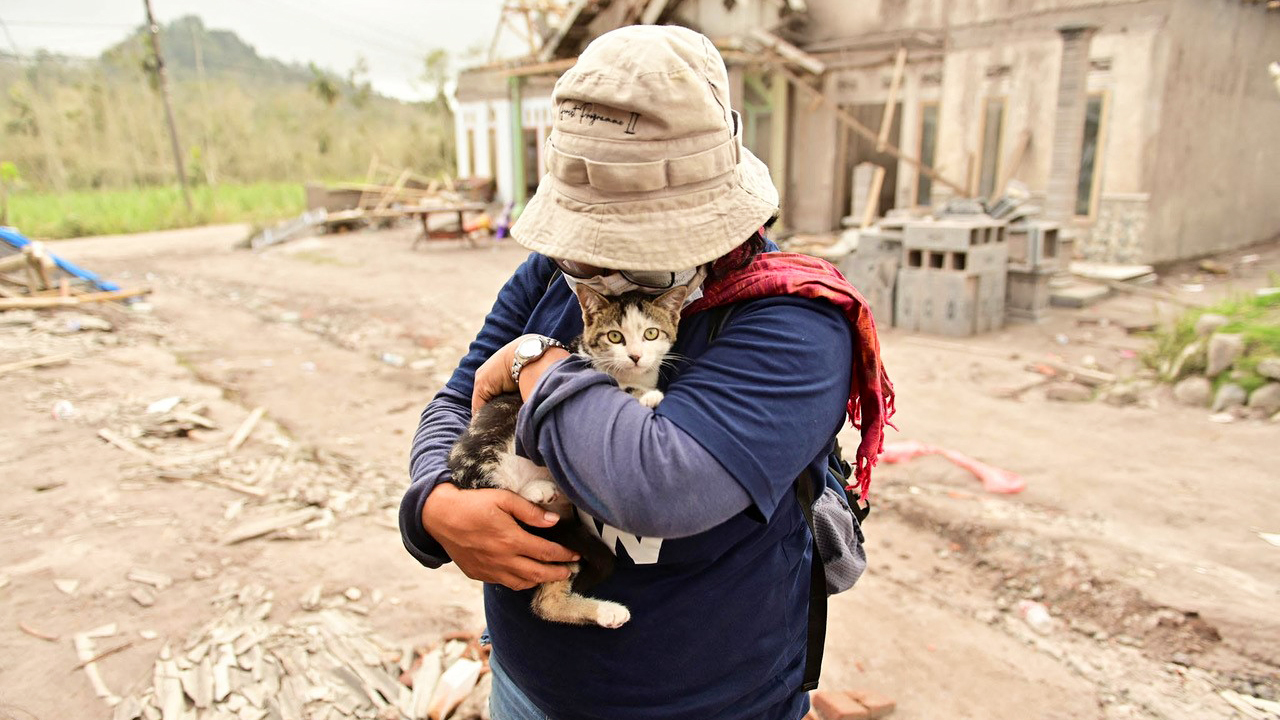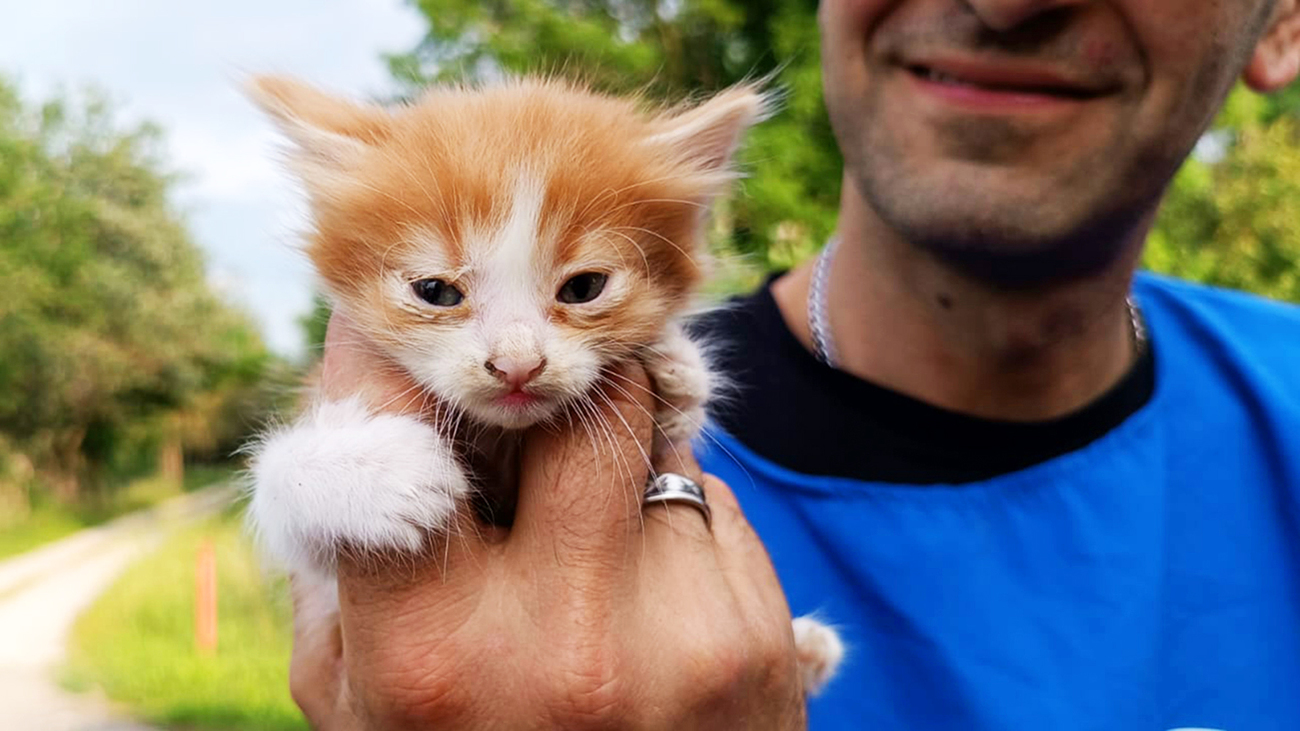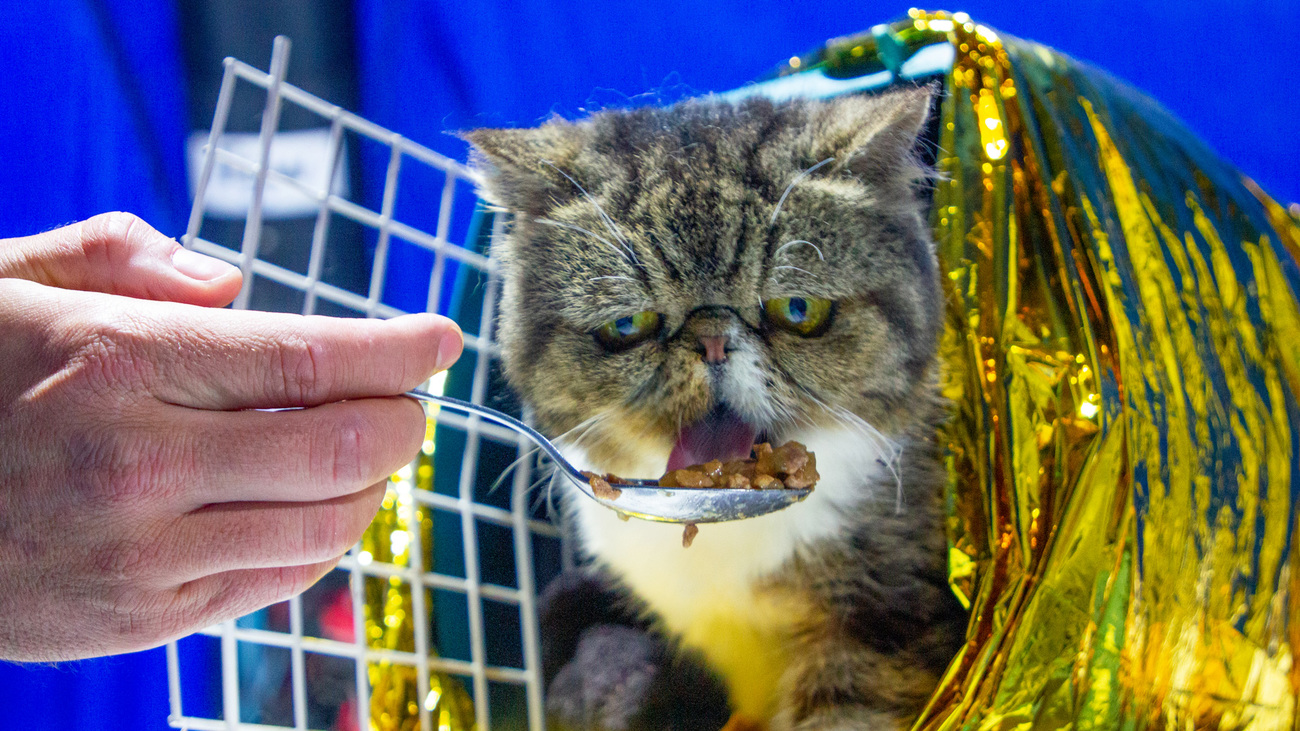Cats
What is a cat?
The Felidae family includes everything from tigers, lions, cougars, ocelots, and lynxes to the domestic cats we keep in our homes. House cats are the smallest feline family members, but otherwise they share many characteristics with their larger, wild relatives. They have a wide variety of fur patterns, retractable claws, flexible bodies, rough tongues, sensitive whiskers, and large eyes with good night vision.
Cats use their long tails to maintain balance, allowing them to walk on various narrow surfaces, like the tops of doors or fences. Their tail movements can also communicate different emotions, such as interest, friendliness, and fear. Cats are one of the most popular pets on the planet, but unlike dogs, humans haven’t had a large hand in selectively breeding the species. Instead, we developed a relationship with cats over thousands of years thanks to our need to stop rodents from eating our food and cats’ natural desire to catch and eat rodents.
Cats are popular largely thanks to their interesting personalities, which are both independent yet needy and affectionate yet aloof. These characteristics could be a product of our naturally developed relationship—while dogs have been selectively bred to love and trust us, cats have been left to their own devices and likely still see themselves as independent but view humans as a potential source of food and shelter.
However, as much as we love cats, their success as a species does have consequences for other animals. There are around double the amount of feral cats as there are house cats worldwide, and as animals that can breed throughout much of or all of the year and produce multiple young at once, their populations can grow very quickly. Their intelligence and competence as hunters, plus their status as an invasive species, make them dangerous to prey species. Ecosystems that didn’t evolve to have cats can be thrown off balance very easily and result in the extinction of species like rodents, small mammals, birds, and reptiles.
What is a cat’s scientific name?
The scientific name for the domestic cat is Felis catus. They are the domesticated members of the Felidae family and are its smallest member.
Where do cats live?
Domestic cats are found worldwide, though their popularity as pets does vary from region to region. The majority of the cat population—400 million out of the 600 million—live in Asia, with 58 million of those being house cats in China. The US tops the charts for cat ownership, with around the same amount of house cats as China despite a much lower human population. The UK is home to around 10.9 million house cats.
Evolution
According to recent studies, today’s domestic cats descend from two main lineages, the first of which came from Asia and into Europe around 4400 BCE. Farming settlements attracted rodents that fed on crops and agricultural byproducts, and the rodents, in turn, attracted their predators—cats. Since fewer rodents meant less trouble for the humans, it’s thought that they allowed the cats to live nearby to cull the rodent population.
The second ancestor is the African wildcat from Egypt, Felis silvestris libyca, which spread into the Mediterranean in around 1500 BCE. It’s thought that this cat may have had social behaviour traits that people liked, and they began taking cats with them along trade routes on land and sea to control rodents while travelling.
Unlike dogs, humans never bred cats for specific purposes; we just developed a symbiotic relationship that led cats to slowly domesticate themselves. Living near humans meant more food to hunt and, eventually, more low-effort food sources as humans began to feed cats directly.
Cats as pets
Our relationship with cats dates back thousands of years, long before they started living with us in our houses. They were considered a sacred animal in Egypt, with ancient Egyptians worshipping the cat god Bastet. Mummified cats from this era have even helped scientists trace and study DNA to learn about the history of cats. Cats were also used in Roman homes as pest control, and they featured in Hindu epics like the Ramayana.
Today, we keep cats as household pets. As many as one third of US households own a cat, and there are over 220 million house cats worldwide. Their popularity stems from their independent personalities, inquisitive nature, cleanliness, and displays of affection. Compared to ever-affectionate dogs, many pet owners feel an increased sense of accomplishment and closeness when they win the affection of a fickle cat.
There are many breeds of domestic cats today. Selective breeding began in the 1800s to create specific breeds with recorded ancestry and high price tags. Today, there are around 73 breeds altogether, each with unique physical and behavioral characteristics.
Disaster preparedness
IFAW is dedicated to rescuing, rehabilitating, and reuniting pets with their owners after disasters such as earthquakes, floods, or human conflicts. However, you can also do a lot to prepare for a disaster before it happens, ensuring you will be ready to keep your pet safe and healthy.
The main things to think about are health and stress levels. If a disaster happens, you need to be able to feed, medicate, and keep your pet as calm as possible while you evacuate and stay away from home.
To prepare, we recommend that you microchip your pet and register their information on a national database, keep up to date with vaccinations, ensure your pet is comfortable traveling in a carrier, and prepare a pet disaster kit.
The kit should include essentials like two weeks’ worth of food, drinking water, a photo of you with your pet, a pet collar with ID, medical records, a pet carrier, portable bowls, a harness or leash, and any necessary medications.
The threats cats pose to wild animals
Domestic cats that are allowed to roam outdoors are technically considered an invasive species by ecologists. After all, they were brought to new places by humans, and, as hunters, they significantly affect the wildlife around them.
According to the Global Invasive Species Database (GISD), domestic cats impact 587 IUCN Red List assessed species worldwide. This means they act as unnatural predators to many endangered or threatened species.
One study claims that feral cats on islands are responsible for at least 14% of bird, mammal, and reptile extinctions worldwide. Once introduced to an island, the clever and competent predators can completely wipe out native species in the contained area. Cats are also considered the principal threat to almost 8% of the world’s critically endangered birds, mammals, and reptiles, including species like the black stilt, the Okinawa woodpecker, and the Cayman Island ground iguana.
FAQs
How long do cats live?
Many things can influence how long a cat lives, including its breed, genetics, lifestyle, diet, and healthcare. In general, the average cat lives for 13 to 17 years. Some individuals can last into their twenties, and the world record holder, Creme Puff, lived to be an impressive 38 years old.
How many cats are there in the world?
Overall, there are an estimated 600 million cats worldwide. Of these 600 million, around 220 million are house cats kept as pets, and 480 million are stray or feral cats.

What do cats eat?
Cats are obligate carnivores, and in the wild, they hunt small animals like birds and mice for sustenance. Being an obligate carnivore means they require nutrients from meat and animal products to stay healthy—so even vegetarian cat owners must feed their cats meat-based foods.
A cat’s diet needs to include large amounts of protein, some fats, and a small amount of carbohydrates. For house cats, commercial foods are properly balanced to provide cats with the nutrients and minerals they need—with wet foods generally being more palatable than dry foods. As for treats, they shouldn’t make up more than 10% to 15% of a cat’s daily calorie intake.
How did cats evolve?
Cat evolution is still being studied, and some details are unknown or are still up for debate. Based on recent studies, it’s thought that domestic cats evolved from both Asian wildcats and African wildcats, who were drawn to human farming settlements due to their dense population of rodents and plentiful food scraps. Rodents were seen as pests that ate crops, so when humans noticed that the cats were helping to keep them under control, the two began living in close proximity and benefitting from each other.
This situation likely continued for thousands of years, and when humans began traveling in boats for trade and exploration, they took cats with them to keep the food stores safe from rodents. This helped cats spread globally and grow even closer to humans.
Why do cats purr?
Kittens first learn to purr just a few days after being born, despite being blind and deaf at the time. They use the sound to help their mothers keep track of where they are and let them know when they want food. This habit continues into adulthood, causing some cats to purr at their owners when they’re hungry.
Some studies also suggest that cats purr when petted to encourage further interaction. This could be due to the positive pattern between human interaction and food that has developed over the thousands of years we’ve been living with cats. When cats allow humans to pet them, they like them more and are more likely to feed them.
Other studies found that cats can adapt their noises for different purposes, so a purr for food might sound different than a purr for petting.

How often do cats go into heat?
Breeding seasons for cats depend on environmental and geographical factors like temperature and number of daylight hours. Breeding season for outdoor cats in the Northern Hemisphere usually occurs from January until autumn, while outdoor cats in the Southern Hemisphere or indoor cats (in a temperature-regulated environment with more light) can often breed year round. During the breeding season, cats cycle between fertile and non-fertile stages, each lasting for three weeks on average.
If you have a pet cat, it’s important to get it spayed or neutered so it does not breed. Stray and feral cat populations are already overwhelming many local wildlife.
How long are cats pregnant?
The gestation period for cats is between 64 to 71 days, with an average of 65 days—about nine weeks.
Can cats see in the dark?
Cats can see in the dark six times better than humans. Compared to humans, they have more rod receptors in their eyes than cone receptors, which helps them see better in low light but reduces the range of colors they can see. They also have a wider field of vision than humans—we can see around 180 degrees, and they can see 200 degrees.
Are cats nocturnal?
Cats are not nocturnal. They’re actually crepuscular animals, which means they’re most active at dawn and dusk. This is common for both predators and animals originating from high-temperature regions. Dawn and dusk are the coolest times of day, so physical exertion consumes the least amount of energy during these times. It’s also a good time for catching prey as they’re just coming out of sleep or just getting sleepy.
How many teeth do cats have?
Like humans, cats have two sets of teeth in their lifetimes—baby teeth and adult teeth. Their 26 baby teeth start appearing from around three weeks of age, and they normally have all 30 of their adult teeth by the time they’re six to seven months old.
What is a group of cats called?
A group of cats is known as a clowder.
Why do cats hate water?
There are a few different theories about why domestic cats hate water. Since they come from dry regions, some think they aren’t used to large bodies of water, and so they avoid them. Others think it’s likely to do with the inconvenience of wet fur. Cat fur takes a fairly long time to dry, isn’t comfortable, and even affects a cat’s agility due to the added weight. It’s also thought that an accidental fall into a body of water can be an unpleasant experience for cats and cause a life-long fear of water.
Despite all this, many cats enjoy playing with running water, likely due to the movement and sounds. Since playing only involves the paws getting wet, it doesn’t cause any inconvenience.
Why do cats meow?
Cats meow to communicate with humans, for instance, when they need help entering a building or room or want food or attention.
How many kittens can a cat have?
The average litter size for a cat is three to five kittens, but some individuals can produce as many as 10.

Our work
IFAW works to help cats and other animals impacted by disasters and conflict around the world. For example, we have been helping vulnerable animals in Ukraine escape the danger of human conflict since February 2022, including domestic pets like cats and dogs.

We also support House of Cats Ernesto, an animal sanctuary in Syria, which is home to over 800 cats, dogs, vervet monkeys, horses, donkeys, wild birds, and domestic farm animals.
Other recent disaster response work includes our earthquake aid in Morocco and emergency aid after wildfires in Hawaii.
In March 2022, IFAW launched Operation Whiskers, a partnership between our disaster response team and local shelters in Louisiana, US, to help rescue cats in the wake of Hurricane Ida.
How can you help?
Cats aren’t currently endangered, but they significantly impact the ecosystems and animals around them. Learning about cats and how they interact with the world is important so we can protect them and other wildlife. Keeping your cat indoors is always a good idea, and it’s also important to spay or neuter it and keep up with its vaccinations.
You can also help prepare your cat for disasters like hurricanes, earthquakes, wildfires, and floods through our #DisasterReady campaign.
